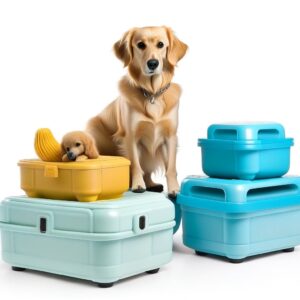best reptile pets The idea that reptiles are pets for a distance is something largely misunderstood. Reptiles can, in fact, offer more rewarding companionship than the traditional cat or dog,
especially if one finds their allure a powerful draw and their nature a lot quieter. Picking the right reptile may be a gateway to learning about these fascinating animals and the responsibilities they come with.
This guide zooms in and focuses on the “best reptile puppies” to smoothen your confident start as a reptile owner.
Why Choose Reptiles as Pets
One may not think about reptiles as the first thing on the list of considerations to have as a pet when discussing it with family members, but this special characteristic of theirs, having low allergenic possibilities, may just make them the perfect choice for many households. First of all,
reptiles are known for low allergenic possibilities. On the other hand, reptiles do not molt dander, which is a common allergen in most furry pets; hence, they are an option ideal for a person who tends to be allergic to allerg.
Landlords even sometimes advise their tenants living in rented apartments or having less space to keep reptiles, as they usually have predictable behaviors and space requirements.
Most intriguingly, their appeal is unique, and the ways of interacting with them are multiple—motivation to get a reptile pet. Whether you have a bearded dragon that watches your every move or a corn snake that lives quietly in your home, one thing is for sure: reptiles do add a piece of the wild to your domestic life.
Great and interesting pets, watched and cared for an experience that would prove rewarding, some of the best food and enrichment for kids in general.
What Makes a Reptile Pet “Best” for Beginners?
All reptiles are not created equally, at least when it comes to the same husbandry requirements. In fact, the term “best reptile pets for beginners” really stands to represent the best options in species available to those just starting in reptiles—or perhaps even starting with pets in general.
Indicators of such pets include: they are quiet animals, require very little care, and have few health problems.
Temperament
another benefit is that the reptile will be beginner-friendly in that they exhibit both a docile nature and be easy to handle.
These are attributes that make it easy for a first-time owner to handle a reptile, therefore making the experience with these creatures less daunting and, consequently, more pleasurable. For example, species that are quite calm include the leopard gecko and corn snakes, which are favorite choices among novices.
Care needs
Another important consideration is that the best beginner reptile cat would not need elaborate setups or highly precise environmental conditions. For instance, leopard geckos would suffice as low-maintenance pets in terms of animal space, and one would not need to buy heavy lighting.

The diet requirements are simple: Normally, the diet is made up of insects such as bought from pet stores. Last but not least, spatial needs must be considered.
Smaller species that are comfortable in modest enclosures make excellent starters for those with limited space. However, not the same diminutive size as some geckos, manageable spaces that can be put into a variety of living environments suit the Russian tortoise just fine.
This will assure that a first-time reptile owner, possibly unsure how well they will take to the responsibility or maybe become disheartened at taking on too much, will have an easier time getting into the reptile care with a pet that will give positive experiences. That is to say, it will encourage a lifelong interest in these fascinating critters.
Top 7 Best Reptile pet for Beginners
When considering the perfect beginner reptile, one needs to consider species that will not only be easy to care for but also create a sense of reward for the owner from having them.
In these regards, the following discusses seven of the top species of reptiles that any owner will need to consider acquiring when making that first reptile acquisition.
Easy-Care Reptile
The Leopard Gecko
Leopard geckos are often hailed as the perfect starter reptile, and for good reason.
Small lizards that do not bite and do very well in captivity without much effort. Care Guide: Simple, basic terrarium providing only moderate heat, minimal hiding areas, and only a small amount of substrate, such as newspaper or reptile carpet.
Diet: Insectivorous animals, easily kept in good health by regularly feeding them with crmini-beetles and mealworms, dusted with vitamin powder. The Social Bearded Dragon
Bearded dragons are another favorite among beginners due to their friendly and sociable nature.
Generally
easy to handle and even often observed to be interacting with their environment during the day. Interaction: Regular, gentle handling is recommended to keep them tame.
Health Needs: The health needs of the corn snakes require a balanced diet of insects, vegetables, with the occasional addition of fruits. Together with proper lighting, to avoid the onset of metabolic bone disease.
Corn snake
This hardy species boasts simple dietary and housing requirements, thus making it an excellent snake pet for the beginner.
Handling: They are generally very placid and rarely show handling problems. Note: Always support the body when handling and ensure that the accommodation is escape-proof.
The Low-Maintenance Russian Tortoise
Russian tortoises are ideal for those who prefer a pet with a longer lifespan and minimal daily maintenance.
Space Requirement
A relatively smaller enclosure will do great, provided that it is perfectly made with a basking area and UVB lighting.
Lifjson

These reptiles make a very long-lasting companion, living for a maximum of 50 years.
Crested geckos are kind of reptile that is easily maintained and occupies minimal space. Diet: Most of their feed shall be commercial food for crested gecko and can be treated with insects.
Skincare: It should maintain the humidity needs for the skin to be healthy and properly change.
The Unique Axolotl
Axolotls are fascinating aquatic creatures that are quite simple to care for once their tank is properly set up.
Water Conditions
A properly cleaned and cool water supply with a properly filtered tank is essential to keep an axolotl healthy.
Unique Features
It has long been a reason for which these animals are very much discussed and debated; limb loss regeneration and perpetual larval state capability indeed make them stand differently in terms of other animal types.
Ball pythons are quite popular because they don’t grow up to be too large, and in the case of being aggressive, they are also extremely docile. Housing: The enclosure has to be escape-proof and should have a gradient of warmth.
Temperature Control: App(ropriate temperature and humidity is required to avoid respiratory diseases and also to permit the snake in proper shedding.
Setting Up Your Reptile’s Habitat
Setting up a comfortable and proper home is just as important as your pet’s health and happiness.
This section is going to guide you through some basic requirements needed in order to establish just the right environment for your particular reptile.
Understanding the Basics of a Reptile Habitat
These include basic principles of almost all reptiles’ habitats, though still each reptjson should have special environmental needs.
Temperature Control: This is because most reptiles, being ectothermic, will depend on the outside environment for body temperature regulation.
Most cases, though, will require the use of heating elements. Lighting: Most reptjson00iles require UVB lighting, just like those that require ultraviolet light for the synthesis of vitamin D3 in the body. Essential Equipment for Your Reptile’s Home
Enclosures
It should be the type of enclosure to be used, hence really determining the size of the reptile and its climbing abilities.
Arboreal species, which include the crested gejson, require a terrarium with height; hence those dwelling on the ground, for example, tortoise, need a space larger from the floor.
Substrate
It is a good substrate, and all that your reptile needs to be in good health is to help you keep the habitat clean.
The substrate can range from paper towels for beginners to more natural setups, such as coconut fiber, a perfect way to maintain humidity.

Heating and Humidity Devices
A proper heat source should be put in place, for example, a ceramic heat emitter or an under-tank heater.
It may even require a person to use a hygrometer in determining the level of humidity within the habitat, which is very much needed while keeping ball pythons or axolotls.
Step-by-Step Guide to Setting Up the Enclosure
Choose the Right Location
Place the cage somewhat away from the direct sunlight and drafts in the house in a location fairly quiet, where it is out of the way.
Install Heating and Lighting
The lamps should be installed on one side of the enclosure to provide the basking area. In case needed, UVB lighting should also be set up.
Add Substrate and Décor
Add hiding spots and climbing structures, which will simulate its natural habitat and help to make the pet feel more comfortable and secure. Put down the selected substrate evenly.
Water and Feeding Stations
Add to the enclosure a shallow water bowl big and of different types or materials, depending on the size and type of reptile.
Maintaining Your Reptile’s Habitat
Keep your reptile healthy with the following steps:
Clean
Clean the cage by replacing the substrates and even disinfect the habitat so that it doesn’t acquire the disease.
Monitor
Check the temperature and humidity of the place periodically to maintain an optimum environment for your reptile.
Daily and Monthly Care Checklist
Proper reptile care includes daily and monthly jobs that affect the health and welfare of your reptile. This part outlines essential care routines that you must carry out for your pet’s welfare, to guide you.
Daily Care Tasks
Giving attention every day to each of these key areas of your reptimal needs may help you ensure your reptile stays in good health. This includes:
Feeding
Determine the proper diet for your reptile; some species live on live insects while others bloom on fresh vegetables. For example, bearded dragons have an all-around diet from both categories, while leopard geckos are mostly insectivorous.
Water
Always ensure that fresh water is available, and at the same time, the water bowl is clean. Reptiles, such as chameleons, might decide to drink water droplets from leaves, hence the need to mist their cage.
Observation
Watch for stress or disease in your reptile. A change in behavior, appetite, or activity level of a reptile may be a warning that something is wrong.
Weekly to Monthly Care Tasks
Daily checks should be looked at, but some areas of care need not be considered on a daily basis, though they are very essential to be in your preview.

Enclosure Cleaning
The habitat should be cleaned and disinfected at least once a month. The substrate should be changed whenever necessary to avoid the waste and bacteria that might have accumulated in the material.
Health Checks
It is assured that a full health check should be given for the reptile, and we should find no visible signs of disease or infection.
He paid much attention to the skin, eyes, mouth, and weight of the reptile, and this will definitely help catch the trouble in time.
Equipment Inspection
Always make sure that all habitat equipment, such as light, heaters, and filters, are operational and risk-free.
Handling and Interaction
Reptiles differ from other pets in the way and extent that they can and should be handled, rather than being handled in a uniform manner as other pets.. However, regular and gentle handling of them is one way to keep your pet from getting wild and accustomed to human interaction.
Handling Tips
Always approach your reptile calmly and gently. In general, it is best to keep interactions short rather than long and infrequent for stress-prone species.
Socialization
For example, social animals such as species like bearded dragons, and sometimes interactivity can imply more than just holding in the hands. In such instances, you should stay close to the vivarium and talk to the reptiles in a low, soothing tone to get them accustomed to your presence.
Common Mistakes to Avoid as a Beginner Reptile Owner
Starting down the reptile-keeping road is exciting but has strings of pitfalls, especially for novices. If novices become familiar with such common pitfalls, this greatly adds to the quality of reptile care that one offers. This article will provide insights into common mistakes and thus lead to a happier, more responsible new reptile companion.
Ignoring Species-Specific Needs
Each reptile species has its unique set of requirements in terms of diet, habitat, and care.
Mistake
Assuming all reptiles eat the same food or require the same type of habitat.
Correction
Know well their individual needs. For instance, while a tortoise will feed on a rich vegetable diet, a snake will only eat live or frozen prey.
Inadequate Habitat Setup
Setting up an appropriate living environment is crucial for your pet’s health and well-being.
Mistake
When lighting and heating are insufficient, people mistakenly use substances as substrates, leading to health problems such as respiratory infections and metabolic bone diseases.
In active voice, the subject of the sentence performs the action. In this case, the subjects are “people”
Correction
The substrate is to be ensured of being of the correct type and kind. The active voice would be While heating and lighting are responsible for replicating the natural environment of the reptile species kept in captivity.
Neglecting Regular Veterinary Care
Reptiles are adept at hiding illnesses, and signs of health issues are not always apparent.
Mistake
Failure to take the reptile to the vet just because the animal seems healthy or underestimates the reptile’s medical care to what most other dog require.
Correction
Schedule regular health checks with a vet experienced in reptile care to catch and treat potential health issues early.
Overhandling
While some reptiles can become accustomed to handling, too much can be stressful for them.
Mistake
Handling the pet too frequently or too roughly, which can lead to stress and health issues.
Correction
Take the time to learn and observe how much handling your pet is comfortable with. Handle the trust-building process carefully to avoid stress.
Poor Hygiene Practices
Maintaining cleanliness is essential for preventing diseases in reptile enclosures.
Mistake
Allowing the enclosure to become dirty or contaminated with old food and waste.
Correction
Regular cleaning of the enclosure and immediate disposal of uneaten food and waste from it will make the place maintainable and healthy for the pet and owner.
Where to Buy Your Reptile and Supplies
Where you obtain your reptile and all of its paraphernalia that come with it probably is just as important as how you take care of them.
This chapter will help you direct yourself to reliable and trustworthy sources for acquiring a new pet and the essentials for getting started with its care.
Choosing a Reptile Seller
The source from which you buy your reptile can have a significant impact on the health and happiness of your pet.
Local Pet Stores
Often convenient, they can range in quality and expertise from awful to some of the best in the world. Do check out the cleanliness of the store and the health of the animals.
Reptile Expos
Generally, you get to meet some of the best and most reputable breeders. Besides, you can get to handle the reptiles, asking the breeders in person about their history and care.
Reputable Breeders
This is through buying from a breeder—one of the good ways of doing this. A breeder can provide valuable history as to the health and lineage of the reptile.
Adoption
Consider adopting from a rescue. This supports animal welfare and gives a home to a reptile in need.
Essential Supplies to Purchase

Properly arming yourself with the necessary supplies from the start can really make the transition to reptile ownership that much easier and more pleasurable.
Enclosure
Choose an enclosure appropriate for the size and type of your reptile. Consider future growth.
Heating and Lighting Equipment
Vital for maintaining the correct temperature and light cycles, which are crucial for your reptile’s health.
Substrate
Select the appropriate substrate for your specific type of reptile to ensure comfort and ease of cleaning.
Decor and Hides
These provide enrichment and places to hide, which help keep your reptile secure and engaged.
Feeding Supplies
Depending on the diet, you might need bowls for food and water, or special feeding tools for live prey.
Tips for a Successful Purchase
Research
Before making any purchases, thoroughly research the needs of the specific type of reptile you plan to adopt.
Ask Questions
When visiting a pet store or breeder, don’t hesitate to ask questions about the reptile’s health, habitat, and diet.
Check Reviews
You will get a good hint from online reviews about the reputation of the seller. Check on feedback pertaining to the quality of the animal supplied to the customer and the type of customer service offered during the transactions.
Conclusion
The beginning of the road to reptile ownership is an exciting and rewarding journey. It allows you to explore the fascinating world of some uniquely charismatic living creatures and develop a relationship that just might yield amazing dividends.
Above all, through this guide, we have discussed indispensable aspects of choosing, caring, and ensuring the well-being of your reptile: from the choice of the right species for beginners, to setting the perfect habitat and understanding the importance of regular care.
Avoid these mistakes by buying your reptile and supplies from a reliable source and knowing what you’re getting into beforehand by using resources such as this blog.
But the key to developing a healthy relationship with your reptile is through consistent care, understanding what they need, and respecting what kind of creature nature has made them to be.
Take the adventure forth, this time armed with more knowledge and curiosity to learn. The more you know about your reptile, the more likely you would take better care of him, and in the end, both you and your pet would be happier.
Whether that is the docile company of a Corn snake or the high-energy activities of a Bearded dragon, your journey in reptile stewardship will sure have interesting findings and pleasures along the way. Happy reptile parenting!











